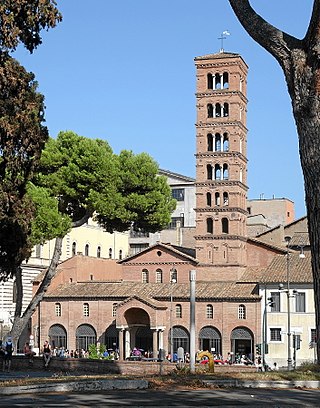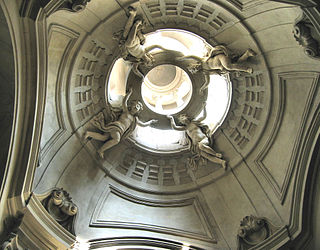
The Church of St. Ignatius of Loyola at Campus Martius is a Roman Catholic titular church, of deaconry rank, dedicated to Ignatius of Loyola, the founder of the Society of Jesus, located in Rome, Italy. Built in Baroque style between 1626 and 1650, the church functioned originally as the chapel of the adjacent Roman College, which moved in 1584 to a new larger building and was renamed the Pontifical Gregorian University.

Santa Maria sopra Minerva is one of the major churches of the Catholic Order of Preachers in Rome, Italy. The church's name derives from the fact that the first Christian church structure on the site was built directly over the ruins or foundations of a temple dedicated to the Egyptian goddess Isis, which had been erroneously ascribed to the Greco-Roman goddess Minerva.

The Basilica of Santa Maria in Trastevere ; English: Our Lady in Trastevere) is a titular minor basilica in the Trastevere district of Rome, and one of the oldest churches of Rome. The basic floor plan and wall structure of the church date back to the 340s, and much of the structure to 1140–43. The first sanctuary was built in 221 and 227 by Pope Callixtus I and later completed by Pope Julius I. The church has large areas of important mosaics from the late 13th century by Pietro Cavallini.

The Basilica of Saint Mary in Cosmedin is a minor basilica church in Rome, Italy. It is located in the rione of Ripa.

Sant'Eustachio is the 8th rione of Rome, identified by the initials R. VIII. It is named after the eponymous church and is located within the Municipio I.

Campo Marzio is the 4th rione of Rome, identified by the initials R. IV. It belongs to the Municipio I and covers a smaller section of the area of the ancient Campus Martius. The logo of this rione is a silver crescent on a blue background.

The Basilica of St. Augustine in Campo Marzio, commonly known as Basilica of St. Augustine and Sant'Agostino, is a Roman Catholic titular minor basilica dedicated to Saint Augustine of Hippo. It is the mother church of the Order of Saint Augustine and it is located just northeast of the Piazza Navona in the rione of Sant'Eustachio in Rome, Italy.

Bernardo Antonio Vittone was an Italian architect and writer. He was one of the three most important Baroque architects active in the Piedmont region of Northern Italy; the other two were Filippo Juvarra and Guarino Guarini. The youngest of the three, Vittone was the only one who was born in Piedmont. He achieved a synthesis of the spatial inventiveness of Juvarra and the engineering ingenuity of Guarini, particularly in the design of his churches, the buildings for which he is best known.

Antonio Gherardi was an Italian painter, architect, and sculptor (stuccoist) of the Baroque style, active mainly in and near Rome and his native city of Rieti.

Charitable institutions attached to churches in Rome were founded right through the medieval period and included hospitals, hostels, and others providing assistance to pilgrims to Rome from a certain "nation", which thus became these nations' national churches in Rome. These institutions were generally organized as confraternities and funded through charity and legacies from rich benefactors belonging to that "nation". Often, they were also connected to national scholæ, where the clergymen of that nation were trained. The churches and their riches were a sign of the importance of their nation and of the prelates that supported them. Up to 1870 and Italian unification, these national churches also included churches of the Italian states.
Giuseppe Sardi was an Italian architect active in Rome. He was born at Sant'Angelo in Vado, Marche which was then part of the Papal States. Known primarily for his church of Santa Maria del Rosario in Marino outside Rome, his name has been linked with the design of the façade of the church of Santa Maria Maddalena in Rome although his involvement with this and with some other building projects remains uncertain. He is not to be confused with the Swiss Italian architect, Giuseppe Sardi (1624–1699), who was active in Venice.
Francesco Peparelli was an Italian architect during the 17th century. According to a contemporary historian, Giovanni Baglione, between palaces, castles, churches and convents, Peparelli participated in about seventy construction projects but only about thirty can be attributed to him with certainty.
Emanuele Rodriguez dos Santos was a Portuguese Baroque architect, principally active in Rome. His most important work is the church of SS. Trinità dei Spagnoli in the via Condotti.

Carlo Francesco Bizzaccheri was an Italian architect. He worked in a Baroque and early Rococo style.

Santa Lucia del Gonfalone is a church in the diocese of Rome, Italy. It is located on Via dei Banchi Vecchi just one block south of Corso Vittorio Emanuele. The former site of the Archconfraternity of the Gonfalone, the Claretian Missionaries have their provincial headquarters here. The church was made a cardinalate deaconry by Pope John Paul II on 21 October 2003.

Santa Maria della Stella is a church located on Via Stella 25 in the quartiere of its name in Naples, Italy.

Santa Maria della Concezione is a church in Rome, located on Piazza Campo Marzio in the Campo Marzio rione. It serves as the national church in Rome for Syriac Catholics.

The Church of Saint Nympha is a Baroque-Mannerist church of Palermo. The facade rises on Via Maqueda, a block north of the central intersection known as the Quattro Canti, in the quarter of Seralcadi, within the historic centre of Palermo. The church belongs to the Camillians.

Santa Maria in Montesanto is a church of Rome, in the Rione Campo Marzio, which stands in Piazza del Popolo, between Via del Corso and Via del Babuino. It is also known as the Church of the Artists. The church is popularly known as the twin church of Santa Maria dei Miracoli, though it shows significant differences especially in the planimetry.
San Camillo dei Mercedari, also called San Camillo de Lellis after its titular saint, or San Camillo ai Crociferi after the founding monastic order founded by Camillo de Lellis, the Camillians known popular as the Crociferi, which also gives name to the street which it faces, via Crociferi. Located on #71, is a Roman Catholic church located in the piazza of the same name in Catania, Sicily, southern Italy; the church is one of four major baroque church-monasteries on this street, the others being San Francesco Borgia (Jesuit), San Giuliano, and San Benedetto.



















